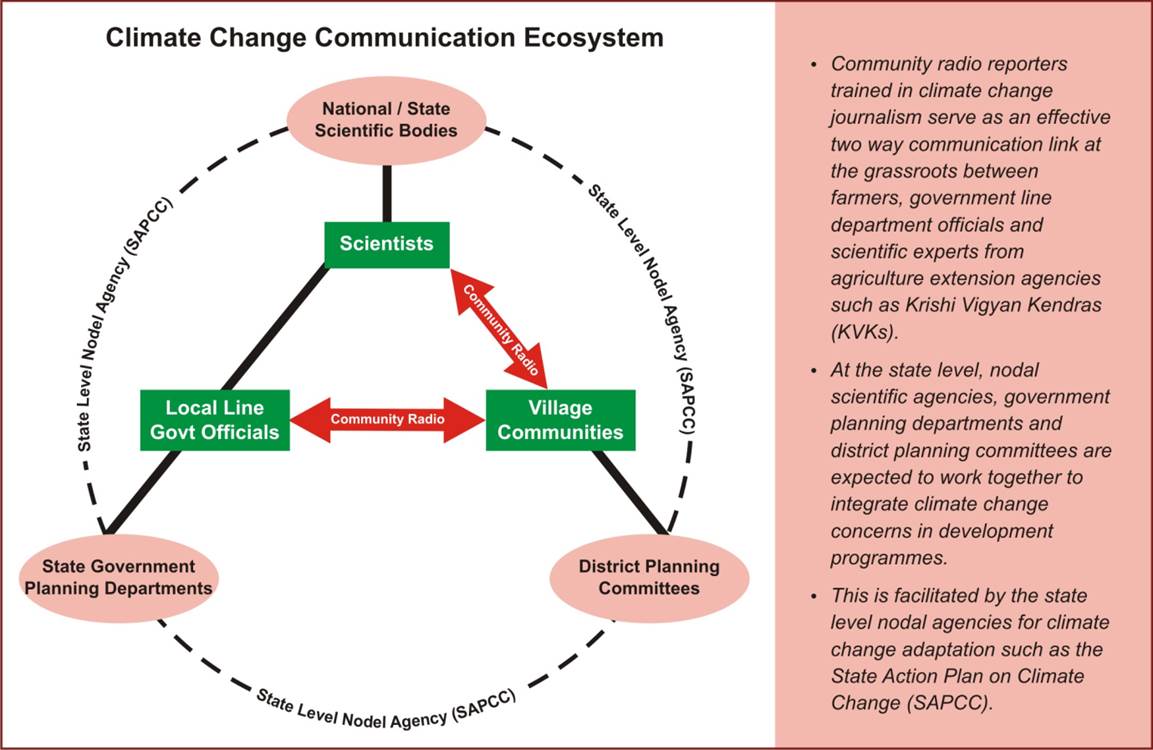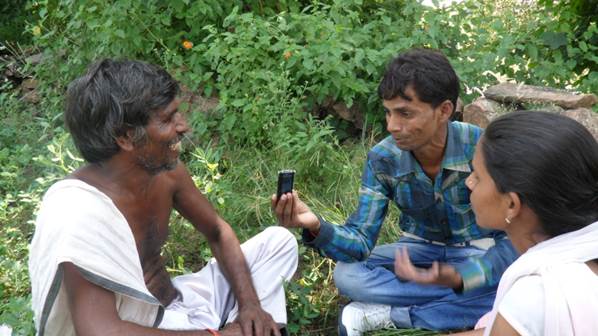|
Community Radio: An Effective Tool for Communicating Climate Change to the Grassroots
C limate change is increasingly becoming one of the biggest threats to economic development worldwide. It has initiated heated debates at international forums, global negotiations and national - regional policy making processes. Media is an important player for climate change communication and plays a significant role in sensitising on issues, increasing dissemination and decoding climate change debates for the masses. However, rural communities dependent on climate sensitive sectors are unaware of these discussions and are largely uninformed about the climatic impacts affecting them directly. One of the most important reasons for this communication gap is absence of community media generating debate on climate change issues at localised level. The vulnerable communities in climate sensitive rural areas are also poorly linked to scientific researchers and policy makers. Limited research currently exists on how to develop strong communication models for multi-stakeholder engagement and exchange of information on climate change adaptation.‘Shubh Kal (for a better
future) - From Information to Knowledg The community journalists from community radios created a dialogue between local communities, scientists and local line department officials on climate change issues through the process of developing radio programmes. Keeping the agriculture based economy of Bundelkhand in mind, the radio programs primarily focused on the farming communities. In the face of change, potential adaptation solutions were shared to increase risk resilience of communities. Shabana, a lady reporter from Chanderi Ki Awaaz expresses that, "I really liked the fact that Shubh Kal programmes discusses problems as well as solutions of climate change. The programmes provided the communities with a medium to convey their concerns to the government officials and scientists who then provided expert advice. So the listeners are presented with all facets of a topic in a single programme." |
 The dynamics of the communication model Community radio is an important component of this communication ecosystem and is placed at the center of this facilitating a two way communication flow process between scientists, communities and local line departments. Local scientific experts who interact with communities through community radio are associated with the national scientific bodies. In the future, these scientific experts will receive an improved understanding of the community’s perceptions and information needs on climate change issues. This information will also help the national scientific bodies design more locally relevant adaptation strategies. Similarly, local government line departments interacting with communities through the community radios are part of the state government planning system. In this communication model, community radios play a critical role in bridging the gap and informing government authorities on how climate change is impacting local development. Subsequently, through these line departments, the model will contribute in conveying this information to state level planners. Lastly, the information provided to the communities from scientists and government line departments through community radios will help the communities take informed decisions on climate resilient adaptation. The small adaptation efforts at the community level can then be up-scaled through planning processes. |
|
In the model, Shubh Kal programmes managed to enable communities to share their experiences in coping with and adapting to climate change. At the same time, the community radio programmes also strengthened community knowledge and voice on climate change impacts and adaptation. Anil Goswami, a farmer from Khaurgar village in Shivpuri district stated that, "earlier we did not know how chemical based farm produce adversely affects our health. When we heard the scientist from KVK Shivpuri explain the ill effects of chemical fertilizers on our soil health and our own health in a Shubh Kal programme, many of us stopped using chemical fertilizers and have started experimenting with organic composts. We also found the information on a government subsidy scheme on vermi composting being talked about by a government official useful." On the other hand, community radio reporters also increased awareness of the scientific community and government authorities on how climate change is impacting local development. The reporters addressed concerns of the farming community by bringing their queries and concerns to the scientists and line department government officials. The reporters also disseminated information from the scientists and the government officials on adaptation options and relevant government schemes to the farming community. Hence completing the loop In information deprived regions like Bundelkhand, there is a need for a dialogue sharing platform for communities, scientists and local government authorities. The Shubh Kal model drew these stakeholders out of their silos to connect, communicate, share and address climate change concerns. The learnings from the model suggest that in order to facilitate implementation of adaptation measures, it is important to communicate appropriate and relevant climate change information to the right audience at the right time. Climate change communication thus forms the backbone of climate change adaptation and adaptive planning. Therefore, there is a strong need for climate change communication which will not only create awareness but also prepares communities and builds resilience. Community radio has proved to be an effective medium to bridge the climate change knowledge gap that exists between communities, scientists and local government authorities. The inclusive yet localised approach of community radio makes it an important tool for meeting the information needs of local communities and supporting communities in adapting to climate change. However, the increased uptake of this model will require providing a certain thrust: 1. There is a need to facilitate and support establishing a network of community radios in climate sensitive regions of the country. 2. Training and capacity building is required for climate change communication to both the new and established community radio stations to effectively help bridge the gap. 3. Climate change impacts differ in different ecological regions hence, agro-climatic regional knowledge centres should be established taking them closer to the community. The potential of community radio can be utilized to feed grassroots information into agro-climatic regional knowledge centres and taking scientific learnings to the community. 4. Community radios could be used by the KVKs and ATMAs to disseminate scientific learnings, bulletins, advisories and success stories to reach out to a wider audience. An ICT tool for marginalised rural communities, community radios are therefore an effective mechanism for communicating climate change information and connecting various stakeholders. q Harshita Bisht
|
 e and
Action’, a pilot initiative was launched last year in Bundelkhand, a
drought prone and climate sensitive region of Central India. Considering
climate change communication needs of the grassroots, Development Alternatives
pilot tested a communication model to facilitate information flow
between scientists (climate change researchers), local government
authorities (implementers for climate adaptive planning) and communities
(climate change information users). The project has created a new space
for dialogue between scientists, communities and local government
authorities to exchange information about climate change impacts and
advocate responses which
address local communities’ needs. Community radio - an important tool
for development communication at the grassroots was used in the model
for facilitating a two way information flow between the three
stakeholders. Four community radios (Radio Bundelkhand, Lalit Lokwani,
Chanderi ki Awaaz and Radio Dadhkan) from Bundelkhand part of Uttar
Pradesh and Madhya Pradesh were engaged in the communication model.
Reporters from the community made radio programs in the local dialects
making the content easily understood by the local populace. These local
radio broadcasters formed an effective communication link between
communities, scientists and policy makers on climate change issues.
e and
Action’, a pilot initiative was launched last year in Bundelkhand, a
drought prone and climate sensitive region of Central India. Considering
climate change communication needs of the grassroots, Development Alternatives
pilot tested a communication model to facilitate information flow
between scientists (climate change researchers), local government
authorities (implementers for climate adaptive planning) and communities
(climate change information users). The project has created a new space
for dialogue between scientists, communities and local government
authorities to exchange information about climate change impacts and
advocate responses which
address local communities’ needs. Community radio - an important tool
for development communication at the grassroots was used in the model
for facilitating a two way information flow between the three
stakeholders. Four community radios (Radio Bundelkhand, Lalit Lokwani,
Chanderi ki Awaaz and Radio Dadhkan) from Bundelkhand part of Uttar
Pradesh and Madhya Pradesh were engaged in the communication model.
Reporters from the community made radio programs in the local dialects
making the content easily understood by the local populace. These local
radio broadcasters formed an effective communication link between
communities, scientists and policy makers on climate change issues.